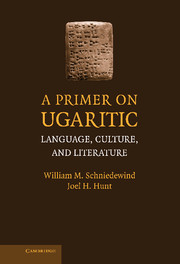8 - Glossary
Published online by Cambridge University Press: 05 June 2012
Summary
UGARITIC LEXICOGRAPHY
The resources for the student in Ugaritic lexicography are quickly becoming quite abundant with the recent publication of G. del Olmo Lete and J. Sanmartín's, A Dictionary of the Ugaritic Language in the Alphabetic Tradition [DULAT] (2002). Indeed, the field has advanced so quickly that even W. Watson's survey of the field in the 1999 Handbook of Ugaritic Studies is slightly out of date. The study of the Ugaritic lexicon is now aided by much more complete resources in other Semitic languages, e.g., Chicago Assyrian Dictionary; Akkadisches Handwörterbuch. And, the Hebrew lexicon by Koehler and Baumgartner includes extensive etymological comparisons.
In spite of advances in lexicography, difficulties in Ugaritic lexicography remain. These problems are easy to understand, but difficult to overcome. The corpus of Ugaritic alphabetic texts is rather limited, and texts are often broken or have limited context. The poetic texts, in particular, often lack context that would help establish precise meanings. Moreover, the nature of poetry as a genre lends itself to ambiguity. The lack of vowels also makes it difficult to establish the exact word. Fortunately, a large number of words are known from cognate languages. In this glossary, we systematically provide cognates from Akkadian and Hebrew for pedagogical reasons. One needs to remember, however, that Ugaritic is not Akkadian or Hebrew.
- Type
- Chapter
- Information
- A Primer on UgariticLanguage, Culture and Literature, pp. 180 - 209Publisher: Cambridge University PressPrint publication year: 2007

